Balmoral Software
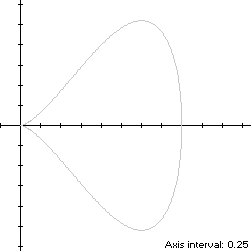
Balmoral Software

x(t) = 1 + sin(t)The curve is traced out clockwise as t increases, starting from the pointy(t) = [1 + sin(t)]cos(t), 0 ≤ t < 2π
 when
when 
x'(t) = cos(t)so by (L1), the perimeter of the piriform curve isy'(t) = cos(2t) - sin(t),
and its area is π. By (C1), its centroid abscissa is
(Note: WolframAlpha has omitted the division by π.)
x''(t) = -sin(t)so by (X1), the piriform curvature changes sign at the origin sincey''(t) = -2sin(2t) - cos(t),
cos(t)[-2sin(2t) - cos(t)] = -sin(t)[cos(2t) - sin(t)]is satisfied for t = 3π/2. Equation (X2) is evaluated with respect to the origin as
which has a solution in the upper half-plane at t = 0, so the convex hull line segments extend between the origin and the points (1,±1). These line segments are shown in blue in the left diagram below, and each has length
 By
(L1), the perimeter of the convex hull is:
By
(L1), the perimeter of the convex hull is:
which is less than 1% shorter than that of the piriform curve.
The line segments of the convex hull create an isosceles triangle with area 1. The centroid abscissa of this triangle is the average of its vertex abscissas, or 2/3. By (A1), the remainder of the convex hull has area
By (C1), the associated centroid abscissa is
The convex hull component metrics can be summarized as follows:
The area of the convex hull is 3.237463, about 3% larger than that of the piriform curve. The centroid abscissa of the convex hull is the weighted average
Region Area Centroid abscissa Product Triangle 1 2/3 2/3 Remainder A = 2/3 + π/2 (4/3 + 5π/8)/A 4/3 + 5π/8 Total 5/3 + π/2 2 + 5π/8
which is 1/(20 + 6π) to the left of the centroid of the piriform curve itself, exactly the same distance as the corresponding value for the teardrop curve.
 of the
piriform curve does not define its inradius since the corresponding abscissa 3/2
is too close to the right edge (2,0), so its incircle is constrained by the
right edge. Using z = 2 in Lemma C, we
have
of the
piriform curve does not define its inradius since the corresponding abscissa 3/2
is too close to the right edge (2,0), so its incircle is constrained by the
right edge. Using z = 2 in Lemma C, we
have
and R = |c - z| =
 . For
verification, we have
. For
verification, we have
d/dt [x(t) - z]y(t) = d/dt -cos3(t)has a zero at t* = 0. The corresponding coordinates are
x* = y* = 1,from which we have
For verification, we have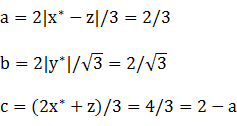
d/dt [x(t) - z]y(t) = d/dt [1 + sin(t)]2cos(t)has a zero at
 The
corresponding coordinates are
The
corresponding coordinates are
from which we have
For verification, we have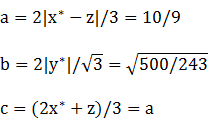
and R = |c - z| = c. For verification, we have
Figure Parameters Perimeter Area Centroid Incircle R = 5.073986 2.048748 (1.192450,0) Inellipse 5.825171 2.418399 (1.333333,0) Piriform curve 7.04249 3.141593 (1.25,0) Convex hull 7.018917 3.237463 (1.224260,0) Circumellipse 8.029365 5.007134 (1.111111,0) Circumcircle R = 8.265940 5.437191 (1.315565,0)
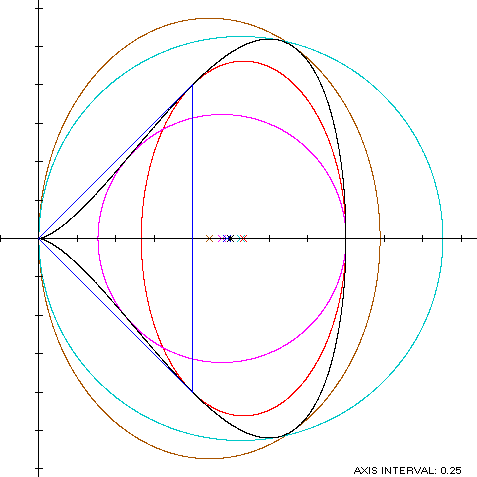
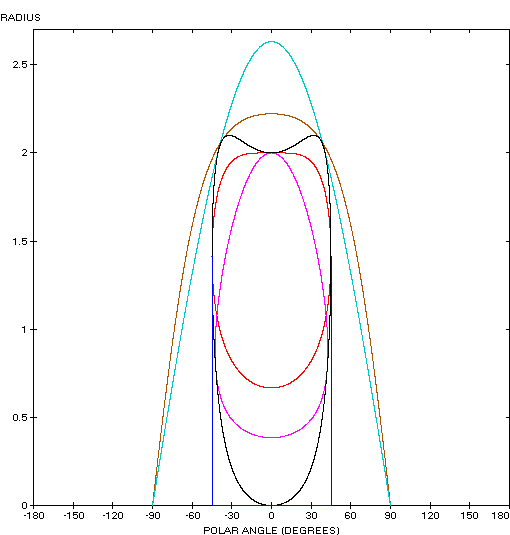
The piriform curve (red) is a member of a group of similarly-shaped figures described on these pages, including (inside to outside) the teardrop curve, the Tschirnhausen cubic, the right strophoid and the Trisectrix of Maclaurin:
The piriform curve adjoins and is the same height as the cardioid:
Copyright © 2021 Balmoral Software (http://www.balmoralsoftware.com). All rights reserved.